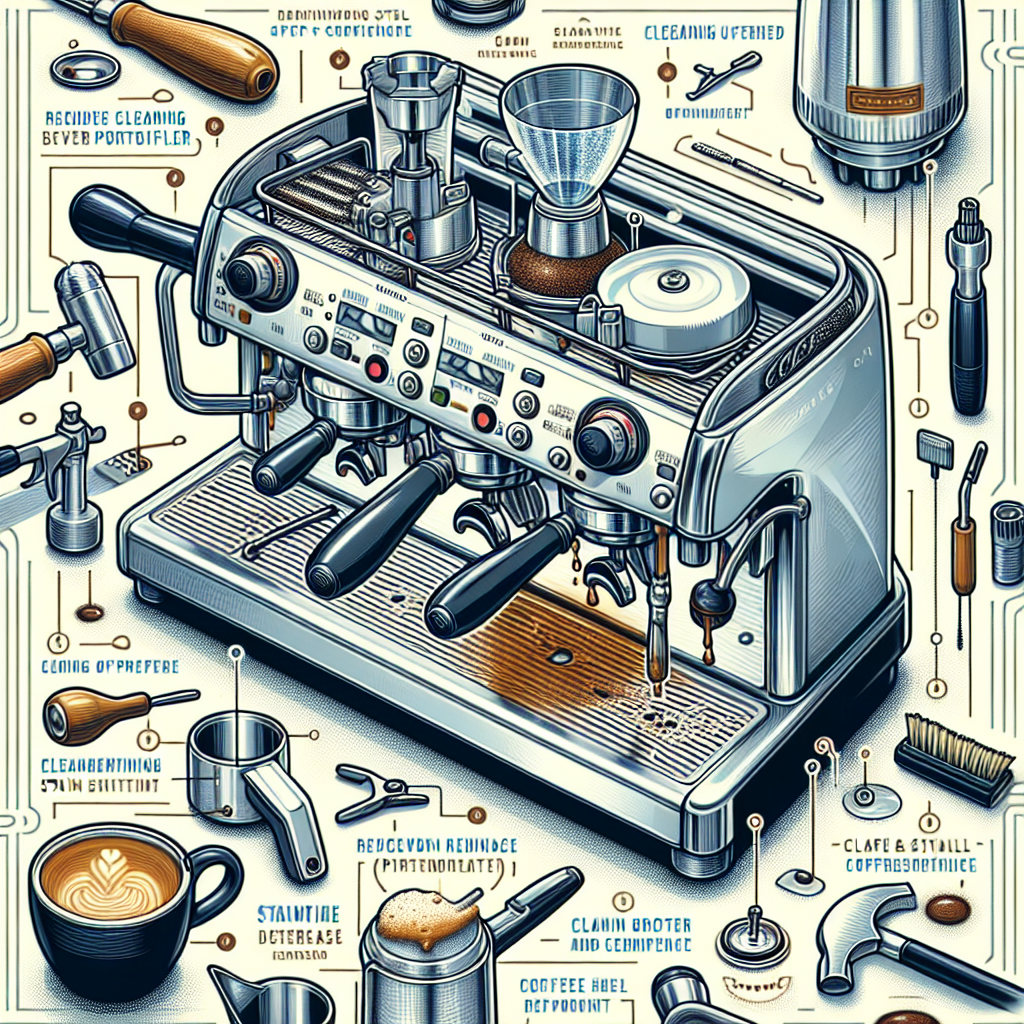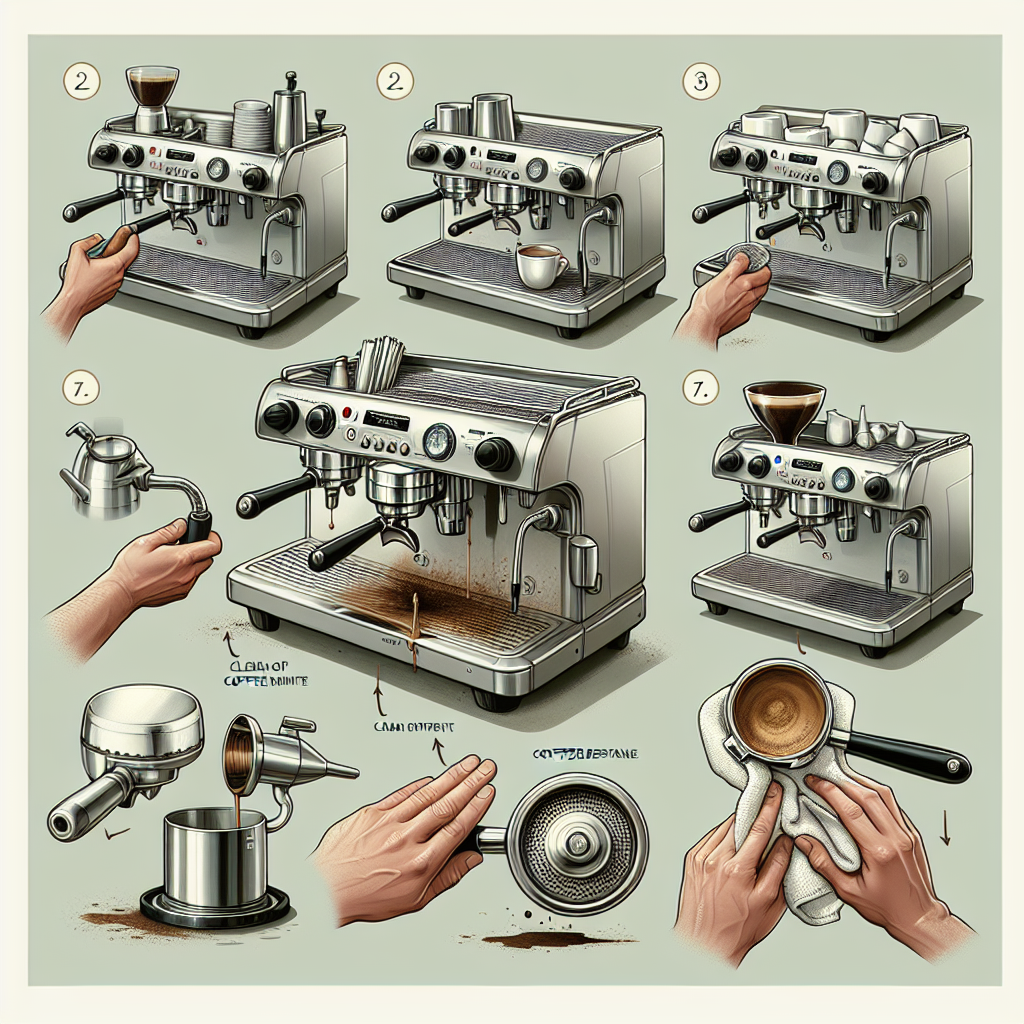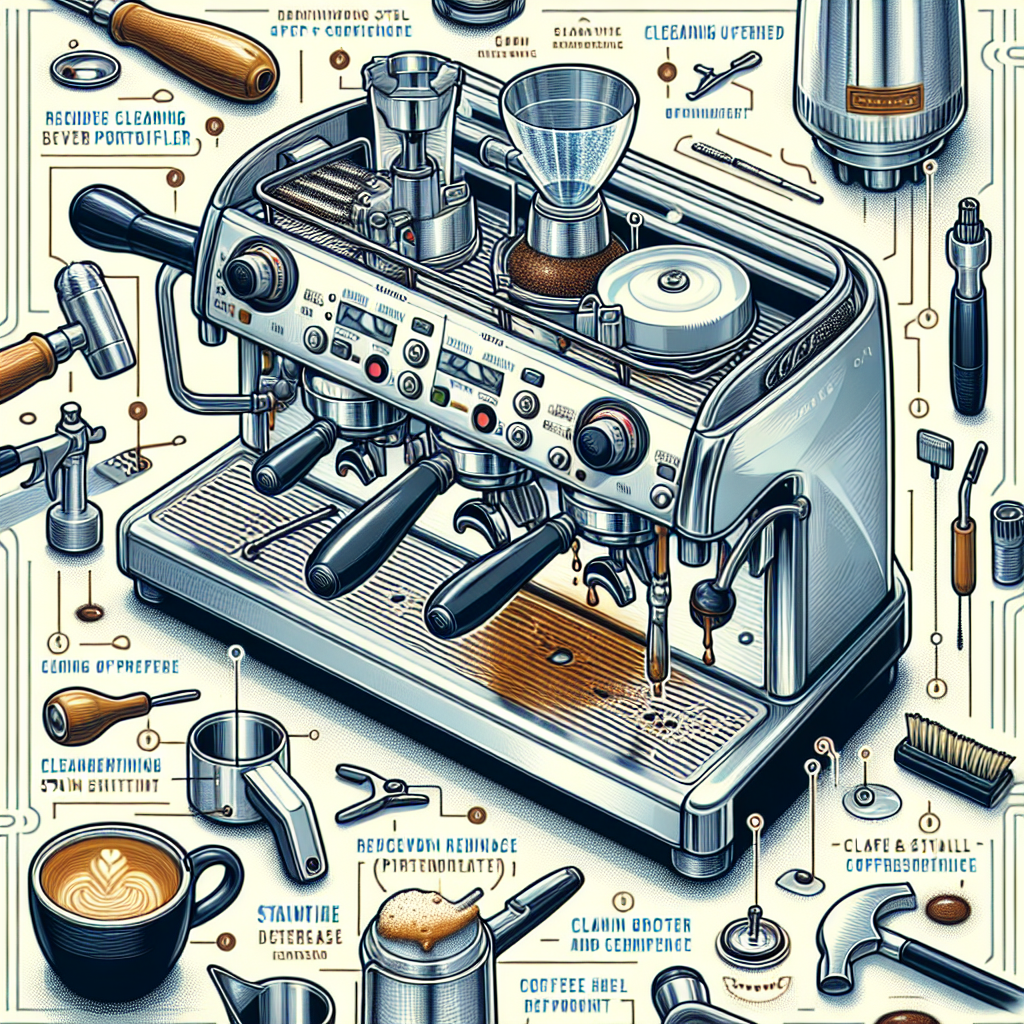
Maintaining and cleaning your stainless steel espresso machine is essential for ensuring a delicious and smooth caffeine fix every morning. In this article, you will discover easy and effective tips on how to keep your espresso machine in tip-top shape, preventing any build-up of residue or potential damage. With our step-by-step guide, you’ll be an expert in maintaining and cleaning your stainless steel espresso machine, guaranteeing a long-lasting and high-quality coffee experience. So, let’s dive in and discover the secrets to a pristine espresso machine!

Cleaning the Exterior
Gathering the necessary supplies
To keep your stainless steel espresso machine looking shiny and new, you’ll need to gather a few essential supplies. Grab a microfiber cloth, mild dish soap, warm water, and a soft-bristle brush. These supplies will help you easily clean and maintain the exterior of your beloved machine.
Wiping down the machine
Start by unplugging your espresso machine and allowing it to cool down. Once it’s safe to touch, dampen your microfiber cloth with a mixture of warm water and a few drops of mild dish soap. Gently wipe down the exterior, paying extra attention to any areas with visible dirt or spills. Remember to avoid using abrasive cleaners or scrubbing excessively, as this may damage the stainless steel surface.
Removing smudges and fingerprints
Stainless steel appliances are notorious for showing smudges and fingerprints, but worry not, as these can be easily removed. Grab your microfiber cloth and dampen it with warm water. Gently rub the cloth over the smudges and fingerprints, applying a bit of pressure if needed. For more stubborn marks, you can use a stainless steel cleaner specifically designed for appliances. Just be sure to follow the instructions provided by the manufacturer for optimal results.
Polishing the surface
Once you’ve cleaned off any dirt, smudges, and fingerprints, it’s time to give your espresso machine a polished look. Grab a clean, dry microfiber cloth and gently buff the stainless steel surface in circular motions. This will help restore the shine and leave your machine looking as good as new. Regular polishing will not only make your espresso machine aesthetically pleasing but also help protect the stainless steel from potential damage.
Cleaning the Portafilter and Filter Basket
Rinsing the portafilter
The portafilter is an essential component of your espresso machine and requires regular cleaning. Start by removing the filter basket from the portafilter and rinsing it under warm water to remove any residual coffee grounds. Then, rinse the portafilter itself, ensuring all coffee residue is thoroughly washed away. Be careful when handling the portafilter as it may still be hot from recent use.
Scrubbing the filter basket
Coffee oils can build up in the filter basket, affecting the taste of your espresso. To keep your brews consistently delicious, a regular scrubbing of the filter basket is necessary. Using a soft-bristle brush, gently scrub the filter basket under warm running water to remove any coffee oils clinging to the mesh. Be sure to reach all the nooks and crannies for a thorough clean.
Soaking in a cleaning solution
For a deep clean, consider soaking the portafilter and filter basket in a cleaning solution. There are various commercial cleaning solutions available specifically formulated for coffee equipment. Follow the manufacturer’s instructions for the appropriate dilution ratio and soak the components for the recommended time. Afterward, rinse them thoroughly under running water before reattaching them to the espresso machine.
Descaling the Boiler
Understanding the importance of descaling
Over time, mineral deposits from tap water can accumulate inside the boiler, hampering the efficiency and performance of your espresso machine. Descaling is crucial to remove these deposits and ensure your machine continues to function optimally. Regular descaling will help maintain the taste of your espresso and prolong the lifespan of the boiler.
Preparing the descaling solution
There are different descaling solutions available, so make sure to choose one that is compatible with your espresso machine. Follow the manufacturer’s instructions to prepare the descaling solution. Typically, this involves diluting the solution with water in the appropriate ratio. Once the solution is ready, pour it into the water reservoir of your machine.
Running the descaling process
Turn on your espresso machine and allow it to run a cycle, pumping the descaling solution through the boiler. Follow the specific instructions provided by the manufacturer, as the process may vary depending on your machine model. It’s essential to ensure all parts of the machine come into contact with the descaling solution. Once the cycle is complete, run several cycles with fresh water to rinse out any remaining solution from the boiler.
Cleaning the Grinder
Removing coffee residue
The grinder is an integral part of the espresso-making process, and it can accumulate a significant amount of coffee residue over time. Regular cleaning helps maintain optimal grind quality and prevents any stale coffee oils from affecting the taste of your brews. Unplug the grinder and empty the hopper of any whole beans. Use a small brush to remove any loose coffee grounds from the burrs and chute.
Brushing the grinder parts
To thoroughly clean the grinder, dismantling it may be necessary. Refer to the manufacturer’s instructions for proper disassembly and reassembly. Once disassembled, use a brush to remove any stubborn coffee residue from the burrs, hopper, and other removable parts. Be gentle with the brushes to avoid damaging the delicate grinder components.
Cleaning the hopper and burrs
After brushing away the coffee residue, wash the hopper and any removable parts with warm soapy water. Make sure to rinse them thoroughly and dry them completely before reassembling the grinder. When cleaning the burrs, it’s important not to use water, as this can cause rusting. Simply brush away any remaining residue and use a soft cloth to wipe them clean.

Cleaning the Steam Wand
Purging the steam wand
Before cleaning the steam wand, it’s important to purge it to remove any residual steam. Turn on your espresso machine’s steam function for a few seconds to release any trapped steam. This step ensures that you can clean the wand without facing potential burns.
Wiping the wand with a cloth
Once the steam wand has been purged, dampen a cloth with warm water and wipe down the entire length of the wand. Pay attention to any milk residue or buildup and gently scrub it away. Avoid using harsh or abrasive cleaners, as they can damage the wand’s surface. Regularly wiping down the steam wand after each use will help prevent the buildup of dried milk and maintain its hygiene.
Soaking the wand in a cleaning solution
For a more thorough cleaning of the steam wand, you can soak it in a cleaning solution specifically designed for removing milk residue. Fill a container with the recommended cleaning solution and immerse the steam wand in it for the suggested amount of time. After soaking, rinse the wand with warm water and wipe away any remaining residue. This process will ensure your steam wand remains clean and free of any milk buildup.
Maintaining the Water Tank
Emptying and refilling the water tank
Regularly emptying and refilling the water tank is essential for maintaining the quality of your espresso machine’s water supply. Begin by unplugging the machine and removing the water tank. Dispose of any remaining water and rinse the tank with warm water. Refill the tank with fresh, filtered water to ensure the best possible taste in your espresso.
Cleaning the tank regularly
While rinsing the water tank with warm water is usually sufficient for regular maintenance, it’s important to give it a more thorough clean every few weeks. To clean the tank, prepare a mild solution of warm water and dish soap. Use a sponge or cloth to scrub the inside of the tank, paying close attention to any visible residue. Rinse the tank thoroughly to remove any soap residue before refilling it.
Using filtered water
Using filtered water is highly recommended to prevent mineral buildup and improve the taste of your espresso. Hard water, which contains high levels of minerals like calcium and magnesium, can cause scale to build up in your espresso machine over time. Filtering your water before filling the tank will help minimize these mineral deposits, ensuring a cleaner and better-tasting cup of espresso.
Keeping the Drip Tray Clean
Emptying the drip tray
The drip tray collects any excess water or liquid that may drip during the brewing process. Regularly emptying the drip tray will help prevent overflow and maintain a clean workspace. Carefully remove the drip tray from your espresso machine, being cautious not to spill any liquid, and discard the contents down the sink. Rinse the tray with warm water to remove any residue before replacing it.
Rinsing and scrubbing the tray
To thoroughly clean the drip tray, rinse it under warm water to remove any remaining residue. If there are stubborn stains or buildup, use a mild dish soap and gentle scrub brush to remove them. Pay attention to the corners and edges of the tray, as these areas can easily collect grime and debris.
Drying the tray
After rinsing and scrubbing, ensure the drip tray is completely dry before reinserting it into your espresso machine. Place it on a clean towel or allow it to air dry to prevent the growth of mold or bacteria. A dry drip tray not only ensures a hygienic brewing environment but also prevents any water damage to the espresso machine’s internals.
Maintaining the Gaskets and Seals
Checking for wear and tear
The gaskets and seals in your espresso machine play a vital role in maintaining proper pressure and preventing leaks during the brewing process. Regularly inspect these components for signs of wear and tear. If you notice any cracks, tears, or deterioration, it’s time to replace them to ensure optimal performance.
Replacing worn-out gaskets
To replace worn-out gaskets, refer to the manufacturer’s instructions or seek assistance from a professional technician. Gaskets typically come in standard sizes, making it easier to find the appropriate replacement. Carefully remove the old gasket and insert the new one, ensuring a snug fit. Properly functioning gaskets will ensure a proper seal and extend the lifespan of your espresso machine.
Lubricating the seals
Keeping the seals properly lubricated is crucial for the longevity of your espresso machine. Apply a food-grade lubricant recommended by the manufacturer to the appropriate seals. This will help create a smooth and secure seal, preventing leaks and ensuring consistent water flow. Regularly lubricating the seals will also prevent them from drying out and cracking.
Cleaning the Group Head
Removing the portafilter
Before cleaning the group head, remove the portafilter if it is still attached to the machine. This will provide better access to the group head and ensure a more thorough cleaning.
Wiping the group head
Using a clean cloth or towel, wipe down the group head to remove any residue or old coffee grounds. Be gentle when wiping to avoid damaging any gaskets or the shower screen. Ensuring the group head is clean will help maintain the integrity and quality of your espresso shots.
Backflushing the group head
Backflushing is an essential step in deep cleaning your espresso machine. It helps remove any buildup of coffee oils and residue in the group head and portafilter. Consult the manufacturer’s instructions on how to properly backflush your specific machine model. Typically, this involves using a blind filter and a cleaning agent to run a backflushing cycle. It’s important to follow the instructions carefully to ensure the best results.
Regular Maintenance Practices
Cleaning the espresso machine daily
To keep your stainless steel espresso machine in optimal condition, it’s crucial to clean it daily. This includes wiping down the exterior, cleaning the group head and portafilter, as well as emptying and rinsing the drip tray. Daily maintenance prevents the buildup of coffee residue, mold, and bacteria, ensuring each cup of espresso is a delight.
Performing deep cleaning weekly
In addition to daily cleaning, performing a comprehensive deep cleaning at least once a week will help maintain your espresso machine’s performance. This deep clean involves descaling the boiler, cleaning the grinder, and thoroughly cleaning the steam wand. Following the manufacturer’s instructions and using the appropriate cleaning solutions will ensure a proper deep clean.
Following the manufacturer’s instructions
Finally, always refer to the manufacturer’s instructions for your specific espresso machine model. Each machine may have different cleaning and maintenance requirements, so it’s important to follow the guidelines provided. This will ensure that you are properly caring for your espresso machine and maximizing its lifespan.
By following these maintenance and cleaning practices, you’ll be able to enjoy delicious espresso from your stainless steel espresso machine for years to come. Regular cleaning not only enhances the taste and quality of your brews but also helps prolong the life of your beloved appliance. So, grab your supplies and give your espresso machine the care it deserves!